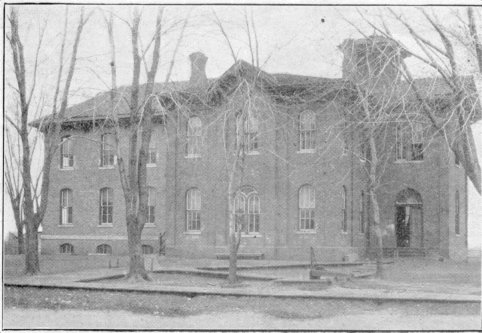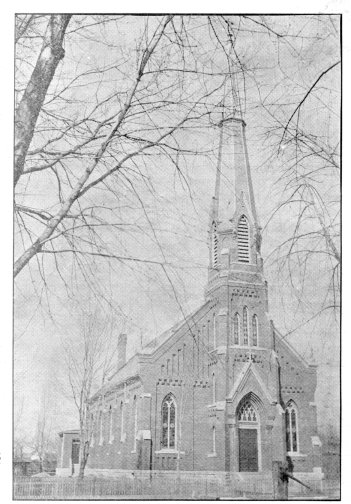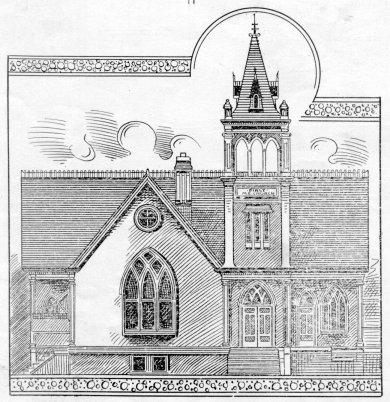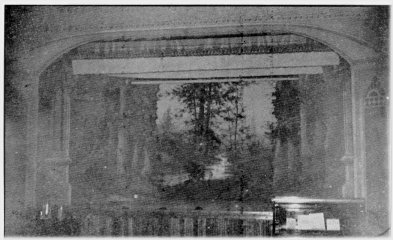Taken from a 1901 Supplement to The (Illiopolis) State Center Record
Illiopolis is a prosperous and enterprising town located On the Springfield division of tile Wabash railroad, sixteen miles west of Decatur, and twenty-three miles east of Springfield. It is situated in the eastern part of Sangamon county. One mile west of the Macon-Sangamon county line. The town site was carved out of land owned by Judge Wilson of Carmi, Ill, in 1856, and for many years was called Wilson after the original grantor; subsequently the name was changed by the railroad authorities to Illiopolis which latter is a compound of Ill. the popular abbreviation for Illinois and polls a Greek word meaning town or city. Because of its being the geographical center of the state its position found favor with the legislators when, in 1837, the question of removing the State Capital from Vandalia was before them for discussion and action, Illiopolis’ advantages were seriously considered. On a vote being taken Springfield’s supporters were in the majority and thus settling finally and decisively the location of the State Capital. Destined thereby to a modest and unpretentious future Illiopolis has grown slowly, steadily and surely. It has never striven for any fictitious boom but has progressed as the rich and fertile country, by which it is surrounded, has been developed and built up. And as for the wealth of natural resources, results, and results alone, justify the claim that the section contiguous to and around Illiopolis is unrivaled in any country or clime. Proofs to this statement may be multiplied but the visitor, whether passing through on the railroad or by wagon or buggy, sees plenty in the great fields of corn, prosperity and thrift in the substantial farm, out buildings, taste, culture and refinement in the possession and enjoyment of handsome homes and modern living accommodations and comforts. The bountiful black prairie yields its profusion of cereals and responds faithfully to that industry so characteristic o-f the farmers of this section. Illiopolis might with equal justice urge its advantages as a manufacturing center, for coal mines are all around and ab3ut it, distant only a few miles, and water may be had in abundance and thus are provided two essentials in industrial enterprises. As for the people of Illiopolis their hospitality is everywhere noticeable in their hearty salutation and cheerful firesides, their marked public spirit strongly manifests itself in the loyal support of local undertakings and enterprises, social and fraternal qualities are in evidence in their many flourishing societies, progressiveness asserts itself in the adoption of advanced ideas, and cultivation speaks only too plainly in the many pretty homes which rival each other in beauty and symmetry. Intertwining all these excellent qualities is a Christian spirit which guides and directs the moral conduct of the people, and which is reflected noticeably in the high standard of the deportment of the young.
MUNICIPAL.
Illiopolis has a well organized and thoroughly disciplined fire department composed of about thirty members. The equipment for fighting fires consist of a chemical engine and ladder wagon. This branch of the public service is in charge of Mr. Jos. Pletz who, as chief renders, as do likewise its members, prompt and efficient service.
SCHOOLS And Educational Facilities.
The educational advantages to be found in Illiopolis are unsurpassed. The course of instruction is both systematic and all the way through and follows the plans laid down by the best educators. The schools are presided over by Mr. L. C. Webb, Principal, assisted by Miss Jennie Taylor in the capacity of Assistant Principal; and J. B. Higginson teacher of the grammar department, Minnie Hurt in charge of the intermediate course of studies, Miss Ellen Scully and Miss Edith
Campbell instructs in the primary
branches. All are thoroughly experienced and have made excellent records as
educators a fact evidenced by the high mental attainment so
characteristic of the youth of Illiopolis. The schools are well attended and
the cooperation rendered by parents in home training contributes largely to
the marked results obtained. The schools are under the direction of a board of
trustees, which comprises the following individuals John W. Constant, Pres.
George E Ford, Dr. J.W. D. Mayes and D. W. Peden, Treas. These gentlemen
possess the esteem and respect of the entire community, are well known and
popular and have never hesitated, when occasion requires, to give their
ability and internal support to public measures generally and especially to
the development of educational advantages, whereby the people may secure for
their children the manifold and invaluable benefits which follow in the wake
of knowledge. As has before been hinted at the Christian spirit pervading the
community is both conspicuous and edifying. it begets and fosters fraternity,
a sentiment and conviction of interdependence, healthy morals and a refinement
in both thought and action.
Illiopolis
Pubic School in 1901
SOCIETIES
The support given a number of
societies of a religious, fraternal and social nature is an excellent
criterion of the people of Illiopolis and vicinity as viewed from a purely
ethical standpoint. The Masonic Lodge No. 521. A. F. and A. M.
was organized in 1867 and its total membership numbers today about
eighty persons. The officers are B. J. Dorrell, W. M.; W. S. Close, S. W.;
P. P. Correll, J. W.; W. A. Mathews, Treas.; C. B. Sutherland, Secy.;
Samuel Garvey, S. D.; J. D. White, J. D.; Albert Norred, Tyler. The lodge
rooms located in the new Masonic Opera House occupy the third floor of the
building and consist of a reception room, two ante rooms, main lodge or
assembly room, banquet hall, toilet rooms and kitchen. These rooms are
handsomely furnished and carpeted throughout, lighted by a gasoline plant
installed in the building and are, in convenience and equipment, a faithful
reflection of advanced ideas in this line. The Knights of Pythias,
organized in 1893 as Center Lodge No. 460, have a membership of over one
hundred. Their officers are: A. C. Sutherland, C. C.; P. P. Correll, V. C.;
John Sheller, Prel.; E M.. Wurl, Earl Prather, M. A.; J.W. Wilson, K.of R. W.;
M. Garvey, M. of Ex.; 0. T. Myers, M. of H.; Fred May, I. G.; John Pickel,
0. G. Their hall and lodge rooms built in 1899, completed and occupied in
March of the present year, covers an area 38 x 56 feet, and consist of
main hall, three reception rooms, property and ante rooms, all of
which are rich in furniture and appointments, handsomely frescoed and carpeted
and reach that point in their neatness and luxuriance which calls forth
effusive compliments and commendations. In this respect they have been ranked
among the finest in the state. Other societies and organizations merit a
more lengthy notice did space allow. These
are the modern Woodman, Royal Neighbors, Royal Circle, King’s Daughters, W.
C. T. U., W. B. F. M., Christian Endeavor Society, Sewing Society, Shakespeare
Reading Club, Bachelor Girl’s Club and others.

Christian Church in 1901


Catholic Church in 1901 Methodist Church Plan in 1901
CHURCHES.
The churches, three in number, represent the Methodist, Catholic and Christian denominations. They are well attended and supported, thus indicating a responsiveness to the welfare and advancement of spiritual affairs. The Methodist church is under the pastorate of Rev. J. A. Stout whose persistent and persevering labor will soon crystallize in a handsome new church which is being built. During his brief stay in Illiopolis Rev. Stout has made a host of friends who admire him for his zeal, earnestness and unremitting toil in diffusing the power and influence of Christianity.
Rev. Fr. Manuel, the esteemed pastor of the Catholic church dedicated to and known as the Visitation of the Blessed Virgin, has labored hard and faithfully for nearly twenty-five years in the spiritual education of his charge. during all these years his excellent qualities of heart and mind have made him an universal favorite, not only among his co-religionists but with the general public as well. All have a kind word for Fr. Manuel and all render him that esteem and homage which sterling qualification never fail to exact.
Elder S. F. Rogers who directs the spiritual affairs of the Christian church ranks among the leading pulpit orators of Central Illinois. His sermons are noted for their logical and interesting treatment of Christian doctrine, betraying at all times an analytical mind, expertness in dialectics, and a familiarity with the best efforts of leading minds in history, science and literature.
RIVERSIDE CEMETERY.
This beautiful “city of the dead” is situated on a bluff overlooking the Sangamon river, and is distant two miles from Illiopolis. Its general appearance evidences that tender care and watchful solicitude prompted by affection and crystallized, by a refined civilization. Such, for instance, are the handsome monuments, artistic tombstones, modest grave marks, floral plenty and variety, and its thickly coated verdure. This cemetery was transferred by the town board this last spring to the Riverside Cemetery Association which is composed of lot owners. It is managed by a board of directors elected by the stock holders. These are now G. XV. Constant, Pres.; D. M. Hurt, Vice Pres.; Dr. J. W. D. Mayes, Sec.; James Johnston, Treas. and W. A. Matthews. A neat booklet, recently issued and containing the by laws of the association, and its rules and regulations, together with a list of lot owners, reflects both system and progressiveness in its management.
Masonic Opera House.
It has been said and the facts prove its truthfulness that few places the size of Illiopolis can lay claim to as handsome, substantial and complete a structure as is the Masonic Opera House. The corner stone of this building was laid August 30, 1899, and it was finished and ready for occupancy in February of the present year. This building is 40x86 feet in dimensions, and contains three stories and a basement. It is heated by a hot air furnace and lighted by a modern gas plant. The theatre has a seating capacity of 500, a large stage equipped with scenery, painted by Sassnian and Landes of Chicago, and a handsome drop curtain the work of J. S. Earhartof Decatur. The third floor of this building contains the hall and reception rooms of the Masonic order and which are also models of interior furnishing and equipment. This building with the opportunities it offers the citizens of this section for amusement and instruction by encouraging high-class theatrical entertainments and lectures, is and will be a monument to that enterprise by which it was conceived and to a degree of culture and taste which sustains and supports pleasing and instructive pastimes. Every week there is some attraction at the Opera House and those living in this section for miles around share alike with the people of Illiopolis the pleasure, of each succeeding occasion.

Inside of Masonic Opera House in 1901

Masonic Opera House on the Pedan Block in 1901
